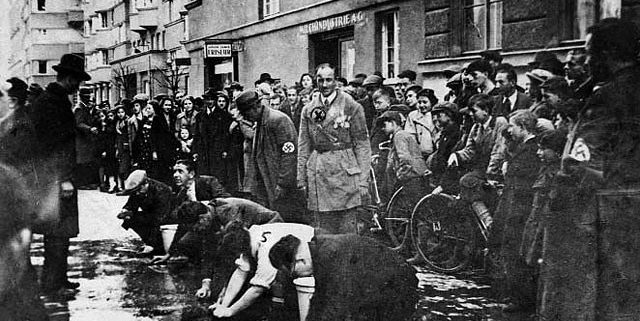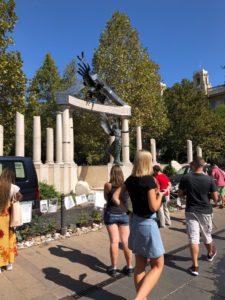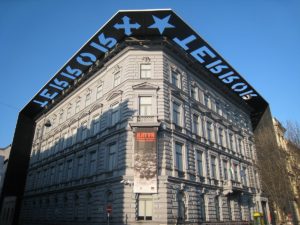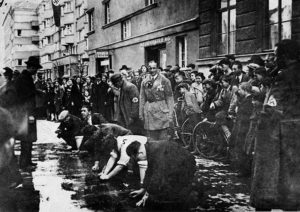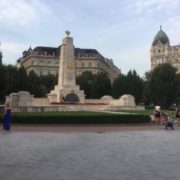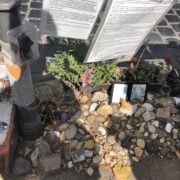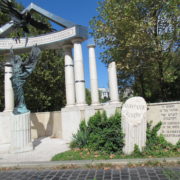What Makes a Nation a Victim?
By Sarah McLafferty
There are certain elements of European history that even those disinterested in the subject are familiar with. Among the most prominent are the events of World War II, and specifically the Nazi perpetration of the Holocaust. While this is discussed throughout middle school, high school, and beyond, oftentimes the history of how nations come to terms with their painful pasts is left out. The post-war years are a traumatic period for the victims of crimes, but also for the perpetrator nations and those nations who played a role, however large, in the events that unfurled.
Upon arriving in Central Europe, I quickly discovered how difficult it is for nations to come to terms with the dark parts of their pasts. In Budapest, one of the first stops on our tour was the Memorial to the Victims of German Occupation. The memorial, built in 2014, depicts a large eagle, representing Germany, swooping down and attacking an angel, meant to be Hungary. This memorial clearly depicts Hungary as the victim, brutally being attacked by aggressive Germany. Without knowledge of the context, it is easy to accept the message of this memorial simply at face value. However, throughout the readings and our discussions in Budapest, I was able to learn that this Hungarian image of victimhood is simply not consistent with what actually occurred. Hungary as a nation played a major role in facilitating Nazi policies in the region. When Adolf Eichmann came to Hungary in 1944, he brought with him only 100 German soldiers. However, by the end of a fifty-six day period, over 400,000 of Hungary’s Jews had been deported to concentration camps. Such an extensive movement of people would not have been possible without assistance from the country’s government. This sense of compliance by the Hungarian government extends also to the society, who by and large stood back and watched as their neighbors were marched out of the country.
While the nation’s official history may try to downplay this, it is important to note that Hungary’s anti-semitic views did not begin with the Nazis entering the country. The country passed one of the first anti-Semitic laws in Europe in 1920, limiting the number of Jews that would be allowed in higher education. The existence of such a law illustrates that many of the sentiments expressed with such brutality during World War II had origins in the past.
One of the most memorable parts of our trip to Budapest was our visit to the House of Terror. This museum, completed in 2002 and built in the former home of the secret police, is dedicated to the victims of the Nazi and Communist regimes. With its emphasis on symbolism over pure facts, the museum seems less like a place of learning and more of a tourist attraction.
When one enters the building they are greeted with the emblems of the Arrow Cross Party, the far right party of Hungary during World War II, and a star, symbolizing the communist party. Based off the two emblems illustrated, it would be safe to assume that the museum would be divided equally between the two time periods. However, out of all of the rooms only two focused on the period of Nazi occupation. The museum seemed all but happy to point out the injustices done by the communist regime, but unwilling to address the involvement of the Hungarian Arrow Cross Party in the atrocities executed by the Nazis. By shining light on this period of history the museum would be forced to address the active role the Hungarian government played in destroying the lives of its very citizens.
After visiting Hungary, I was curious to see if the theme of victimhood would continue in the other countries we visited. In Vienna I witnessed another country that had a great difficulty accepting the role it played in the events of World War II. At the Center for Documentation of Austrian Resistance we saw a number of illustrations of the terrible events that occurred during the war. One of the most striking images was that of Hitler being welcomed to Vienna by a giant crowds of Austrians. There were thousands of people, crowding the city square to get a view of him as he arrived. Not only was Hitler welcomed, but as we later learned, there were areas that had been taken over by local, Austrian Nazis even prior to his arrival in the country.
It was mind boggling to think that a nation that had welcomed this man with such open arms could later turn around and claim that they were the victims of occupation. At the Center we also saw an image of Jews being made to clean the city streets while their fellow citizens stood by and watched. We learned that this was ordered not by the leadership in Berlin, but in Vienna. Yet still, possibly the most telling and shocking bit of information I learned during this visit was that it was not until 1991 that the Chancellor of Austria stated that the nation was co-responsible for the Holocaust and the murder of Austrian citizens.
The visits to sites dealing with national memory illustrated the troubles governments face when dealing with their nations’ past actions. Nations that continue to deny their involvement in atrocities prevent their citizens from recognizing the past and delay the process of moving forward. In countries where the line between victims and perpetrators is blurred, facing the past it is even more challenging. Our travels helped me realize that history cannot be explained in black and white terms, and that differentiating between the “good” and “bad” guys, is a lot harder than it appears

